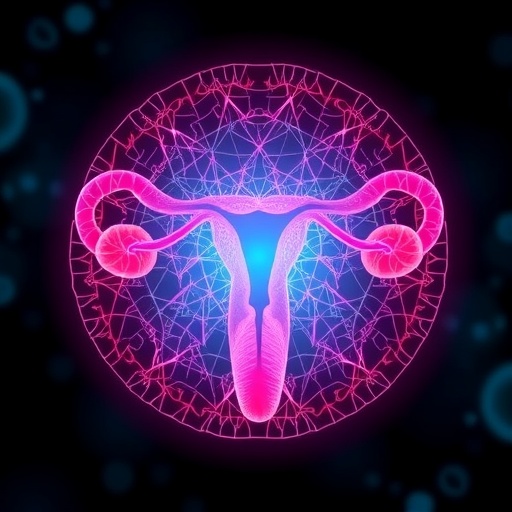In a groundbreaking development poised to revolutionize our understanding of female reproductive biology, researchers at Rice University have unveiled a novel mathematical framework that deciphers the complex physics underlying ovarian aging and menopause timing. This study, recently published in The Journal of Physical Chemistry Letters, introduces a stochastic, multistage model that captures the intricate dynamics of ovarian follicle depletion, offering unprecedented insights into why menopause generally unfolds within a narrow age window across diverse populations. This theoretical advance promises to pave the way for predictive tools capable of transforming reproductive health strategies on an individual basis.
At the heart of this research is the realization that ovarian follicles—the microscopic structures harboring immature eggs—do not decline randomly over time. Instead, their attrition follows a synchronized pattern governed by probabilistic transition rates across developmental stages, culminating in an accelerated phase of follicle depletion during midlife. This phenomenon, previously unresolved, explains the pervasive observation that most women experience menopause within a similar age bracket, despite wide genetic and environmental variability. By mathematically representing the ovary’s functional lifespan as a chain of chemical-like reactions, the model captures the stochastic journey of follicles as they either mature or undergo programmed death.
The implications of this research extend far beyond theoretical biology. By decoding the quantitative mechanisms regulating follicle progression and demise, it provides a conceptual scaffold for the development of predictive models that clinicians could use to anticipate the onset of menopause with greater accuracy. This marks a significant shift from the traditional reactive framework of reproductive health toward a proactive, personalized medicine paradigm. Women could soon access tailored reproductive forecasts, optimizing fertility planning and interventions such as egg freezing or hormonal therapies based on their unique biological timelines.
This model conceptualizes the ovarian aging process as a complex, multistage stochastic system akin to sequential chemical reactions. Each follicle transitions probabilistically through developmental phases, with distinct stage-specific rates dictating the likelihood of progression or mortality. Remarkably, when these rates align, follicles collectively enter synchronized progression, producing the tightly regulated window of menopause onset observed in clinical populations. This synchronization ensures that the depletion process is not merely a byproduct of randomness or wear but an orchestrated biological event with temporal precision.
One of the most striking revelations from this study is the reevaluation of follicle death, traditionally viewed as purely wasteful. The model suggests that programmed follicular atresia plays a critical regulatory role in ovarian physiology. By selectively culling less viable follicles, this process accelerates the maturation of healthier follicles, maintaining overall ovarian function and ensuring orderly progression through developmental stages. This nuanced understanding repositions follicle death as a key physiological mechanism that modulates reproductive aging.
The potential clinical applications are vast. Fertility specialists could leverage these insights to create individualized predictions for menopause timing by integrating a woman’s biological data—including follicle counts, hormonal profiles, and genetic markers—into the stochastic model. Such precision forecasting could inform decisions regarding optimal childbearing periods, timing of fertility preservation strategies, and anticipation of menopausal symptoms, thus improving quality of life and reproductive outcomes.
Another promising avenue lies in preventive care. Early detection of atypical acceleration in follicle depletion may serve as a biomarker for premature ovarian insufficiency or other reproductive disorders. By identifying these risks at an incipient stage, clinicians can intervene sooner, potentially mitigating long-term health consequences such as osteoporosis, cardiovascular disease, and cognitive decline associated with early menopause.
Data comparisons underpinning the model underscore a pivotal “inflection age” during midlife when follicle attrition rates escalate markedly. This discovery harmonizes with epidemiological findings and biological observations, reinforcing the model’s biological plausibility. The precision in pinpointing this critical threshold provides a quantifiable target for monitoring women’s reproductive health trajectories over time.
The research not only offers theoretical clarity but also imbues the biological clock—a traditionally abstract and anxiety-inducing concept—with tangible structure and predictability. By decoding the hidden kinetics of ovarian aging, this work empowers women with knowledge that could alleviate uncertainty, enabling informed reproductive life planning grounded in personal biology rather than population averages or vague estimations.
While the current study remains theoretical and does not immediately translate into clinical treatments, it establishes an essential groundwork for future innovations in reproductive medicine. By formalizing ovarian aging as a stochastic, regulated process, it invites interdisciplinary collaboration among biologists, clinicians, mathematicians, and engineers to develop real-world applications, from diagnostic tools to therapeutic protocols.
Rice University professors Anatoly Kolomeisky and Zhuoyan Lyu, leading figures in this interdisciplinary investigation, emphasize the transformative potential of integrating quantitative modeling with reproductive science. Their work exemplifies the power of applying physical chemistry principles to biological complexities, ushering in a new era of personalized reproductive health grounded in precise mechanistic understanding.
Funding from the Welch Foundation, the National Institutes of Health, and the National Science Foundation underscored the project’s significance, ensuring robust support for this pioneering exploration. As additional data accumulate and computational techniques advance, the predictions derived from this stochastic approach are likely to become increasingly refined, rendering the vision of predictive and preventive women’s health care ever more attainable.
In conclusion, the introduction of a stochastic chemical kinetics framework to ovarian aging unearths synchronized follicle depletion as the fundamental driver of menopause timing. This elegant model not only demystifies a critical biological milestone but also heralds a paradigm shift toward predictive and personalized reproductive health management. With continued research, this theoretical blueprint holds the promise of transforming women’s reproductive well-being from uncertainty to clarity and from reaction to anticipation.
Subject of Research: Investigating biological mechanisms underlying ovarian aging and menopause timing through a stochastic mathematical model.
Article Title: Investigating Mechanisms of Ovarian Aging and Menopause Timing Using a Stochastic Approach
News Publication Date: 23-Jul-2025
Web References:
10.1021/acs.jpclett.5c01933
References:
The Journal of Physical Chemistry Letters, DOI: 10.1021/acs.jpclett.5c01933
Image Credits:
Photo by Jeff Fitlow/Rice University
Keywords:
Menopause, Reproductive system, Random processes, Human reproduction, Pregnancy, Human fertilization




